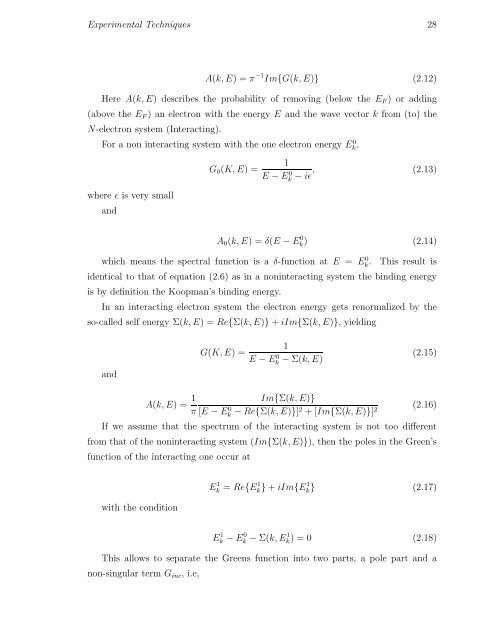PHYS07200604007 Manas Kumar Dala - Homi Bhabha National ...
PHYS07200604007 Manas Kumar Dala - Homi Bhabha National ...
PHYS07200604007 Manas Kumar Dala - Homi Bhabha National ...
You also want an ePaper? Increase the reach of your titles
YUMPU automatically turns print PDFs into web optimized ePapers that Google loves.
Experimental Techniques 28<br />
A(k, E) = π −1 Im{G(k, E)} (2.12)<br />
Here A(k, E) describes the probability of removing (below the E F ) or adding<br />
(above the E F ) an electron with the energy E and the wave vector k from (to) the<br />
N-electron system (Interacting).<br />
For a non interacting system with the one electron energy Ek,<br />
0<br />
G 0 (K, E) =<br />
where ǫ is very small<br />
and<br />
1<br />
(2.13)<br />
E − Ek 0 − iǫ,<br />
A 0 (k, E) = δ(E − E 0 k) (2.14)<br />
which means the spectral function is a δ-function at E = Ek 0 . This result is<br />
identical to that of equation (2.6) as in a noninteracting system the binding energy<br />
is by definition the Koopman’s binding energy.<br />
In an interacting electron system the electron energy gets renormalized by the<br />
so-called self energy Σ(k, E) = Re{Σ(k, E)} + iIm{Σ(k, E)}, yielding<br />
and<br />
G(K, E) =<br />
1<br />
E − E 0 k − Σ(k, E) (2.15)<br />
A(k, E) = 1 π<br />
Im{Σ(k, E)}<br />
[E − E 0 k − Re{Σ(k, E)}]2 + [Im{Σ(k, E)}] 2 (2.16)<br />
If we assume that the spectrum of the interacting system is not too different<br />
from that of the noninteracting system (Im{Σ(k, E)}), then the poles in the Green’s<br />
function of the interacting one occur at<br />
with the condition<br />
E 1 k = Re{E1 k } + iIm{E1 k } (2.17)<br />
E 1 k − E0 k − Σ(k, E1 k ) = 0 (2.18)<br />
This allows to separate the Greens function into two parts, a pole part and a<br />
non-singular term G inc , i.e,
















